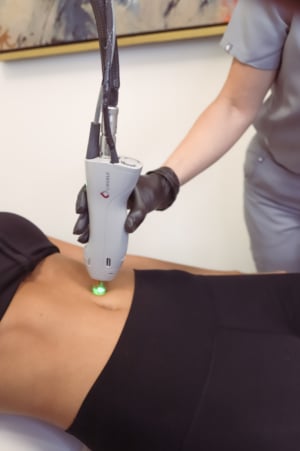
In the realm of medical aesthetics, laser technology has emerged as a groundbreaking solution for various applications, with laser hair removal being one of the most popular. But how did this technology come into existence? Who were the pioneers behind its discovery and subsequent advancements?
The Birth of Laser Technology
The concept of lasers (Light Amplification by Stimulated Emission of Radiation) was first proposed by physicist Albert Einstein in 1917. However, it took several decades before his ideas became a tangible reality.
In 1960, Theodore Maiman, an American physicist, built the first working laser using a synthetic ruby crystal. This milestone marked the birth of laser technology, opening up a world of possibilities in various scientific and medical fields.
The Advent of Laser Hair Removal
The development of laser hair removal as a cosmetic procedure can be attributed to two significant discoveries: selective photothermolysis and the concept of melanin absorption.
Selective Photothermolysis: In 1983, Dr. Rox Anderson and Dr. John Parrish introduced the concept of selective photothermolysis, which revolutionized laser treatments. This concept involves using a specific wavelength of light that is selectively absorbed by the target tissue while minimizing damage to surrounding areas. This breakthrough laid the foundation for safe and efficient laser-based hair removal.
Melanin Absorption: Melanin, the pigment responsible for hair color, became a crucial factor in the development of laser hair removal technology. Scientists realized that by targeting the melanin in hair follicles, they could effectively destroy the follicles without harming the surrounding skin. The discovery of melanin absorption paved the way for laser hair removal devices that could selectively target and eliminate unwanted hair.
The Pioneers
Dr. Thomas B. Fitzpatrick, a dermatologist, played a vital role in advancing laser hair removal technology. In the late 1980s, he conducted extensive research on laser treatment for hair removal and established its effectiveness in reducing hair growth. Dr. Fitzpatrick’s contributions significantly influenced the development of subsequent laser devices and treatment protocols.
The Arrival of GentleLASE and GentleYAG
In the late 1990s, Candela Corporation (now Syneron Candela) introduced two pioneering laser devices for hair removal: the GentleLASE and the GentleYAG.
The GentleLASE, utilizing an Alexandrite laser with a wavelength of 755 nm, proved highly effective for individuals with lighter skin tones and finer hair. Its selective targeting of melanin in the hair follicles made it a game-changer in the field of laser hair removal.
Meanwhile, the GentleYAG, operating at a longer wavelength of 1064 nm, offered a solution for individuals with darker skin types and coarser hair. The Nd:YAG laser’s deeper penetration into the skin reduced the risk of surface damage while effectively destroying hair follicles.
The Birth of GentleMax Pro
Building upon the success of the GentleLASE and GentleYAG systems, Syneron Candela introduced the GentleMax Pro. This groundbreaking device combined the power of both lasers, offering practitioners unmatched versatility and the ability to cater to a broader range of skin types and hair colors. With the added Dynamic Cooling Device (DCD), the GentleMax Pro ensures client comfort and enhances the safety profile of the treatment.
The Future of Laser Hair Removal
Laser hair removal has come a long way since its inception. Ongoing advancements in laser technology continue to refine the process, making treatments more efficient, comfortable, and accessible to a wider range of individuals. Today, laser hair removal is a highly sought-after procedure, providing long-lasting results and freeing individuals from the burden of unwanted hair.
As we look to the future, further advancements in laser technology are anticipated. Researchers and scientists are continually exploring ways to enhance the precision, speed, and effectiveness of laser hair removal treatments. This includes the development of advanced cooling systems to improve client comfort, refining laser wavelengths to target specific hair colors and skin types more effectively, and exploring new techniques to optimize the process.
Moreover, the integration of artificial intelligence and machine learning algorithms into laser devices holds great promise. These technologies can assist practitioners in customizing treatment parameters based on individual characteristics, leading to even more precise and tailored results.
It is also worth mentioning that laser technology has expanded beyond hair removal. Today, lasers are used in various medical and cosmetic procedures, including skin rejuvenation, tattoo removal, scar revision, and vascular lesion treatment. The versatility and efficacy of lasers have made them a cornerstone of modern aesthetics and dermatology.
The Takeaway
The discovery and evolution of laser technology have revolutionized the field of hair removal. From the early experiments and breakthroughs in selective photothermolysis and melanin absorption to the development of advanced laser systems like the GentleMax Pro, laser hair removal has become a safe, effective, and sought-after procedure.
The contributions of scientists, physicists, and medical professionals have propelled the field forward, expanding its applications and improving client experiences. With ongoing research and technological advancements, laser hair removal is poised to continue its trajectory of growth, offering even more precise and efficient treatments in the future.
As the demand for long-lasting hair removal solutions increases, laser technology will likely remain at the forefront, empowering individuals to feel more confident and comfortable in their own skin.





